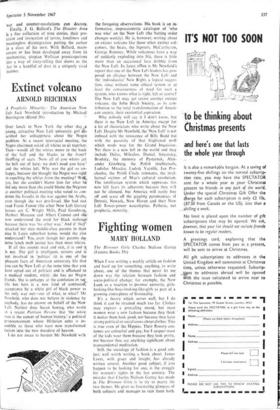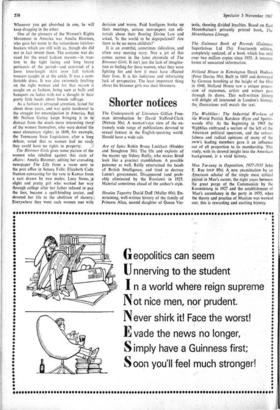Fighting women
MARY HOLLAND
The Bloomer Girls Charles Neilson Gattey (Femina Books 35s) When I was writing a weekly article on fashion and hard up for something, anything, to write about, one of the themes that never let me down was the relation between fashion and socio-political change; for example, the New Look as a reaction to postwar austerity, girls- looking-like-boys-looking-like-girls as part of a growing atmosphere of bisexuality.
It's a theory which serves well, but I do think it can be strained much too far. Clothes may express a prevailing mood, but most women wear a new fashion because they think it makes them look good, not because they have strong political or social views about clothes. This is true even of the Hippies. Their flowery cos- tumes are colourful and gay, but I suspect most of the kids wear them because they look pretty, not because they say anything significant about transcendental meditation.
Still, the sociology of fashion is a good sub- ject, well worth writing a book about. James Laver, with grace and insight, has already written several. Another good subject, if you happen to be looking for one, is the struggle for women's rights in the last century. The mistake that Charles Neilson Gattey has made in The Bloomer Girls is to try to marry the two themes. He gives us fascinating glimpses of both subjects and manages to ruin them both. Whenever you get absorbed in one, he will keep dragging in the other.
One of the pioneers of the Women's Rights Movement in America was Amelia Bloomer, who gave her name to the voluminous knicker- bockers which are still with us, though she did not in fact invent them. The costume was de- vised for the usual fashion reasons—in reac- tion to the tight lacing and long heavy petticoats of the period—and consisted of a loose knee-length skirt over full turkish trousers caught in at the ankle. It was a com- fortable dress. It was also extremely fetching on the right woman and for that reason it caught on as fashion, being seen at balls and banquets on ladies with not a thought in their pretty little heads about female suffrage.
As a fashion it attracted attention, lasted for about three years, and was quite incidental to the struggle for- emancipation in America. But. Mr Neilson Gattey keeps bringing it in to distract from the much more interesting story' of the women themselves, who were denied the most elementary rights; in 1849, for example, the Tennessee State Legislature, after a long debate, voted that as women had no souls they could have no rights to property.
The Bloomer Girls gives some picture of the women who rebelled against this state of affairs: Amelia Bloomer, editing her crusading. newspaper The Lily from a room next to the post office in Seneca Falls; Elizabeth Cady Stanton canvassing for the vote in Kansas from a cart drawn by two mules; Lucy Stone,* slight and pretty girl who worked her way through college after her father refused to pay the fees, became a spell-binding orator, and devoted her life to the abolition of slavery.; Everywhere they went such women met with derision and worse. Paid hooligans broke up their meetings, serious newspapers ran edi- torials about their flouting Divine Law and asked, 'Is the world to be depopulated? Are there to be no more children?'
It is an eventful, sometimes ridiculous, and often very moving story. Not a jot of this comes across in the lame chronicle of The Bloomer Girls. It isn't just the lack of imagina- tion or feeling for these women, what they were fighting for and how it must have affected their lives. It is his ludicrous and infuriating lack of perspective. The least important thing about the bloomer girls was their bloomers.











































 Previous page
Previous page